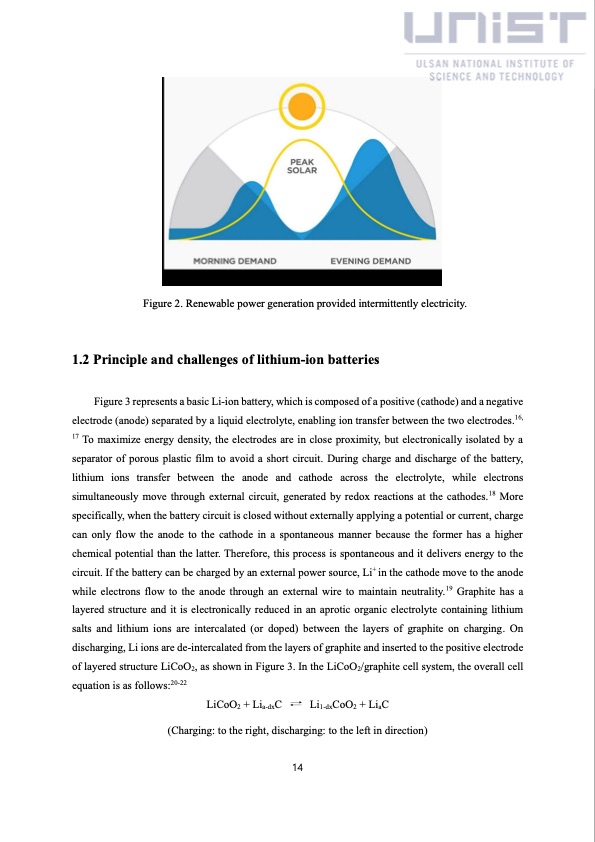
PDF Publication Title:
Text from PDF Page: 019
Figure 2. Renewable power generation provided intermittently electricity. 1.2 Principle and challenges of lithium-ion batteries Figure 3 represents a basic Li-ion battery, which is composed of a positive (cathode) and a negative electrode (anode) separated by a liquid electrolyte, enabling ion transfer between the two electrodes.16, 17 To maximize energy density, the electrodes are in close proximity, but electronically isolated by a separator of porous plastic film to avoid a short circuit. During charge and discharge of the battery, lithium ions transfer between the anode and cathode across the electrolyte, while electrons simultaneously move through external circuit, generated by redox reactions at the cathodes.18 More specifically, when the battery circuit is closed without externally applying a potential or current, charge can only flow the anode to the cathode in a spontaneous manner because the former has a higher chemical potential than the latter. Therefore, this process is spontaneous and it delivers energy to the circuit. If the battery can be charged by an external power source, Li+ in the cathode move to the anode while electrons flow to the anode through an external wire to maintain neutrality.19 Graphite has a layered structure and it is electronically reduced in an aprotic organic electrolyte containing lithium salts and lithium ions are intercalated (or doped) between the layers of graphite on charging. On discharging, Li ions are de-intercalated from the layers of graphite and inserted to the positive electrode of layered structure LiCoO2, as shown in Figure 3. In the LiCoO2/graphite cell system, the overall cell equation is as follows:20-22 LiCoO2 + Lia-dxC Li1-dxCoO2 + LiaC (Charging: to the right, discharging: to the left in direction) 14PDF Image | China solar seawater battery

PDF Search Title:
China solar seawater batteryOriginal File Name Searched:
solar-seawater.pdfDIY PDF Search: Google It | Yahoo | Bing
Product and Development Focus for Salgenx
Redox Flow Battery Technology: With the advent of the new USA tax credits for producing and selling batteries ($35/kW) we are focussing on a simple flow battery using shipping containers as the modular electrolyte storage units with tax credits up to $140,000 per system. Our main focus is on the salt battery. This battery can be used for both thermal and electrical storage applications. We call it the Cogeneration Battery or Cogen Battery. One project is converting salt (brine) based water conditioners to simultaneously produce power. In addition, there are many opportunities to extract Lithium from brine (salt lakes, groundwater, and producer water).Salt water or brine are huge sources for lithium. Most of the worlds lithium is acquired from a brine source. It's even in seawater in a low concentration. Brine is also a byproduct of huge powerplants, which can now use that as an electrolyte and a huge flow battery (which allows storage at the source).We welcome any business and equipment inquiries, as well as licensing our flow battery manufacturing.| CONTACT TEL: 608-238-6001 Email: greg@salgenx.com | RSS | AMP |